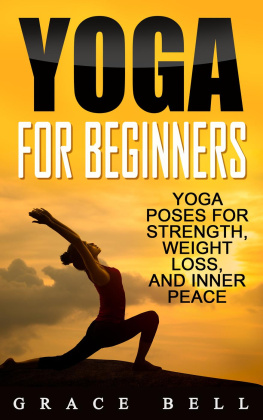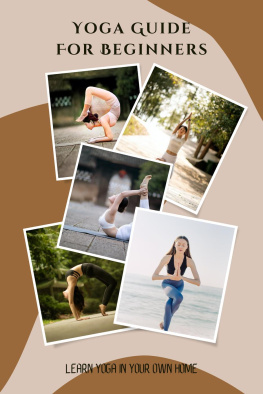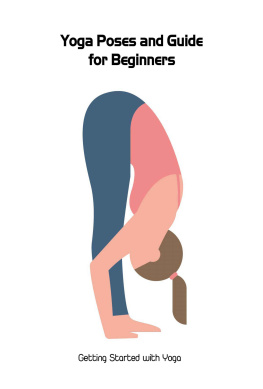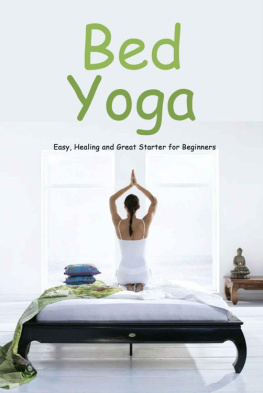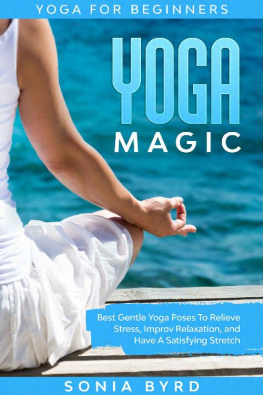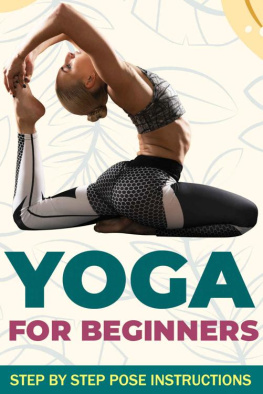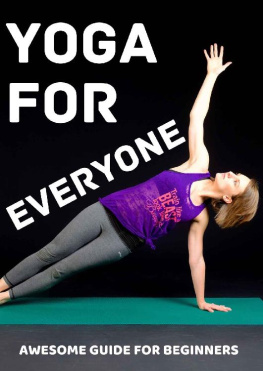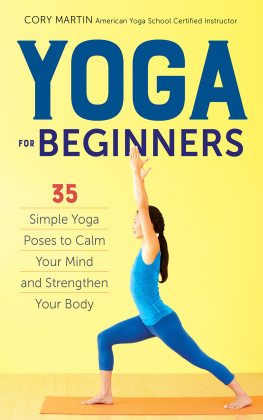This book is dedicated to mymentor, my older sister who introduced me to the inner peace that yoga brings.
Chapter 1- Before Yoga There Was Meditation Get This Right First
Thereare articles and books everywhere that extol the virtues of meditation. Itimproves concentration, reduces anxiety, and increases your capacity to feeland achieve happiness. The effects of meditation can be felt even after one ortwo sessions, but meditations full benefits are truly felt when it becomes along-term practice.
Allof the good press meditation garners makes it wildly popular, and lots ofpeople want to give meditation a try. Unfortunately, not many stick to it. Oneof the biggest reasons why meditation doesnt always quite stick is becausefolks tend to go into it with the wrong kind of mindset.
Nowadays,instant gratification is pretty much the name of the game for almosteverything. The goal is often maximum results for minimum effort. Peopleusually get into something in the hope that they get something back right away,without really intending to commit to it until significant, palpable resultsare seen. If you want to seriously start meditating however, that isnt theproper frame of mind to bring into the activity. Meditation isnt aboutresults; its a long-term practice that enriches your life because it has becomea part of it.

Ifyoure new to meditation, here are a few tips to help you integrate meditationinto your life.
- Make a point to set specific times for meditation every day. Early mornings are especially great for meditation. This time of the day is generally quieter, and your mind will probably be a little less cluttered with the worries and events of the day. For example, since its a great idea to meditate twice per day, you can designate 6:00am-6:30am and 10pm-10:30pm as your daily meditation times. Making meditation a part of your daily ritual will help you maintain the habit. Youre actually setting aside the time for it rather than trying to squeeze it in with all of the other activities you may have going on in your life.
- Designate a meditation spot in your house. If you have the space for it, set aside a specific room and make it an exclusive spiritual or prayer room. If youre pressed for space, just make sure that your meditation spot is separate from where you sleep, exercise, or work. Getting into a meditative state of mind is much easier when you have an area that you can easily associate with serenity and relaxation.
- Hang up the do not disturb! sign. People who are new to meditation tend to overlook the little disturbances that interrupt us throughout the day, and during meditation time, this can make your practice even more difficult than it already is. Its a little hard to enter a relaxed, meditative state when youre worrying about the phone ringing or your kids waking up. During meditation time, turn off your phone, inform your household that you are not to be disturbed, lock your door, and make the effort to move past the little worries that your mind might create while youre trying to meditate.
- Try to create meditative moments throughout the day. Your practice can be greatly enhanced by making your meditation part of your life. This doesnt mean that you have to sit in a corner in a lotus position every two hours; generating a moment of awareness can be as simple as being conscious of your breath and what you are physically doing at the time. These moments can help ground you and make you more conscious of how you process things. This can really help you develop your meditation habits.
- Acknowledge changes. Meditation newbies can often find the practice rather frustrating. Sometimes though, even a minute physical or environmental change can help things click into place.
- Get a meditation partner. Meditating with someone you trust can help you make your practice more consistent. This person can be a spouse or partner, a sibling, a close friend, or even a teacher. This also has the added bonus of potentially deepening the relationship you share with this other person. However before you start, it is important to set some ground rules. Someone elses meditation style may clash with yours, so be sure that you and your meditation partner are on the same page. This ensures that your meditation sessions will go smoothly and harmoniously.
- Commit to your meditation practice. Meditation is not about results; its a way of life. Dont look at it in terms of daily outcome, rather, try to think of meditation as simply a part of your life, and do what you can each day.
- Chill out! Meditation can come in a lot of different forms, but all of them require a practitioner to relax so that they can focus more easily. What does this mean? It means that you must try to avoid going into your meditation time feeling nervous or angry. Dont sweat the small stuff. If youre having trouble focusing or relaxing, dont stress out over it. Acknowledge your feelings, let them run their course, and just let go. While youre there, do what you can. Its OK.
- Be grateful. If youre new to meditation, you might sometimes feel more frustrated than serene at the end of a session. Thats OK! Meditation isnt about winning or losing. So afterwards, take a few minutes to let yourself feel good about your own powers of concentration, and about the fact that you have the chance to practice.
- And finally, when you start losing interest in meditation, do something about it! Meditation takes effort and commitment, and when your interest starts to wane, this is precisely when you need to practice the most! Reinvigorate your practice; revisit the books or CDs youve used to help you with your practice, and reconnect with whatever meditation support system you might have.
Eventhough meditation can help you achieve a state of ease and serenity, thepractice itself isnt easy. On the other hand though, meditation is a trulyenriching exercise. It can give your life more fullness and dimension, and allyou need to do is make meditation a part of it.
Chapter 2- Follow My Techniquesto Meditate Before Starting Yoga
Inthe simplest terms, meditation is about completely focusing ones attention ona single object, concept, or action. There are several different ways tomeditate, and many different belief systems built around different kinds ofmeditation, but in a nutshell, that is all that meditation is. Doesnt soundtoo difficult, does it? Unfortunately though, it isnt quite as easy as itseems. Sitting or lying down somewhere and not visibly doing anything might notlook that tough, but most of us will probably start feeling antsy after a fewminutes of doing it.


